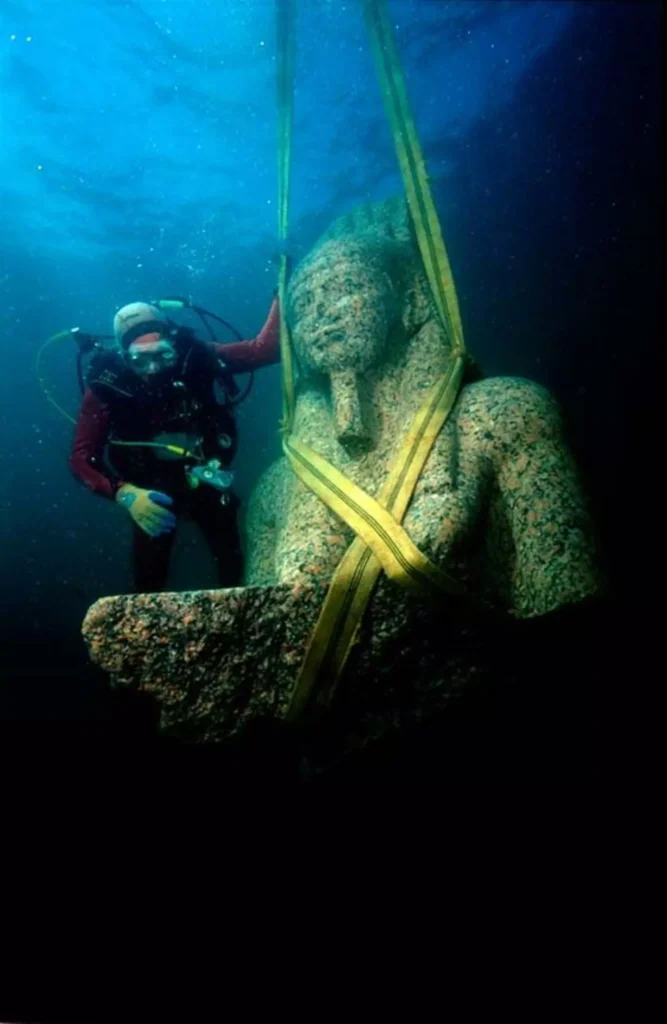Thonis-Heracleion, a bustling trade hub over 2,300 years ago, was once hailed as the “Venice of the Nile.” This city was a crucial center of cultural and commercial exchange between ancient Greece and Egypt. However, it vanished from maps after a series of natural disasters, including earthquakes, tsunamis, and rising sea levels. Over time, it became buried under layers of sand and mud at the bottom of the Mediterranean Sea.

Table of Contents
ToggleA Historic Excavation – Uncovering the Temple of Aphrodite
A team led by renowned marine archaeologist Franck Goddio has unearthed the ancient temple of Aphrodite, the Greek goddess of love and beauty. Buried under more than a meter of sediment, the temple contained a treasure trove of gold, silver, and alabaster ritual objects. This discovery has been likened to opening a “time capsule,” offering profound insights into the city’s glorious past.
The Historical and Cultural Significance of the Temple
The temple was not only a center of worship but also a symbol of the cultural fusion between Egypt and Greece. Artifacts such as golden jewelry, alabaster jars used in rituals, and intricately crafted silver items reveal the luxurious lifestyle and spiritual practices of its inhabitants.
The Temple of Aphrodite and Greek-Egyptian Cultural Exchange
The temple’s relics showcase a unique blend of Greek artistry and Egyptian religious traditions. This reflects the deep cultural interactions in a society where traders and citizens from both civilizations coexisted and thrived.

Analyzing the Disaster – Why Did Thonis-Heracleion Sink?
Geological studies have revealed that the city’s submersion was caused by a combination of natural factors:
- Earthquakes and Land Subsidence: Frequent earthquakes weakened the Nile Delta’s soft soil, causing the city to collapse under its own weight.
- Tsunamis and Climate Change: Powerful tsunamis and rising sea levels submerged the city within a short period.
- “Compaction Sinking” Phenomenon: This occurs when soil becomes compressed under pressure and water, lowering the land below sea level.
These factors not only destroyed the city but also preserved it beneath the seabed, allowing archaeologists today to uncover its remnants.

The Significance of the Discovery for Human History
The discovery of Thonis-Heracleion extends far beyond archaeology, offering valuable insights into:
- Cultural exchange in ancient times: The city’s story highlights the role of trade and migration in shaping civilizations.
- Religious practices and rituals: Artifacts from the Temple of Aphrodite reveal how ancient societies blended religions to suit their diverse communities.
- Environmental disasters: Thonis-Heracleion serves as a reminder of humanity’s vulnerability to natural forces, a lesson especially relevant in the era of climate change.
Directions for Future Research
The excavation of Thonis-Heracleion is just the beginning. Researchers hope further analysis of the artifacts will deepen our understanding of:
- The trade networks and economic systems of the Mediterranean region.
- How ancient people adapted to and survived in disaster-prone areas.
Conclusion
The discovery of the Temple of Aphrodite and the city of Thonis-Heracleion is a remarkable journey back in time. Beneath the deep sediment of the Mediterranean lies the story of a thriving metropolis where culture, religion, and commerce converged. This forgotten city not only unveils the past but also poses fascinating questions about the rise and fall of ancient civilizations.
